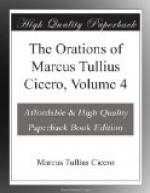C. P. Indeed they do. Nor are they called devoid of art because they really are so, but because it is not the art of the orator which produces them, but they are brought to him from abroad, as it were, and then he deals with them artistically; and this is especially the case as to witnesses. For it is often necessary to speak of the whole class of witnesses, and to show how weak it is; and to urge that arguments refer to facts, testimony to inclination; and one must have recourse to precedents of cases where witnesses were not believed; and with respect to individual witnesses, if they are by nature vain, trifling, discreditable, or if they have been influenced by hope, by fear, by anger, by pity, by bribery, by interest; and they must be compared with the authority of the witnesses in the case cited, where the witnesses were not believed. Often, also, one must resist examinations under torture, because many men, out of a desire to avoid pain, have often told lies under torture; and have preferred dying while confessing a falsehood to suffering pain while persisting in their denial. Many men, also, have been indifferent to the preservation of their own life, as long as they could save those who were dearer to them than they were to themselves; others, owing to the nature of their bodies, or to their being accustomed to pain, or because they feared punishment and execution, have endured the violence of torture; others, also, have told lies against those whom they hated. And all these arguments are to be fortified by instances. Nor is it at all uncertain that (since there are instances on both sides of a question, and topics also for forming conjectures on both sides) contrary arguments must be used in contrary cases. There is, also, another method of disparaging witnesses, and examinations under torture; for often those answers which have been given may be attacked very cleverly, if they have been expressed rather ambiguously or inconsistently, or with any incredible circumstances; or in different ways by different witnesses.
XV. C. F. The end of the oration remains to be spoken of by you; and that is included in the peroration, which I wish to hear you explain?
C. P. The explanation of the peroration is easy; for it is divided into two parts, amplification and enumeration. And the proper place for amplification is in the peroration, and also in the course of the oration there are opportunities of digressing for the purpose of amplification, by corroborating or refuting something which has been previously said. Amplification, then, is a kind of graver affirmation, which by exciting feelings in the mind conciliates belief to one’s assertion. It is produced by the kind of words used, and by the facts dwelt upon. Expressions are to be used which have a power of illustrating the oration; yet such as are not unusual, but weighty, full-sounding, sonorous, compound, well-invented, and well-applied, not vulgar; borrowed from other subjects,




